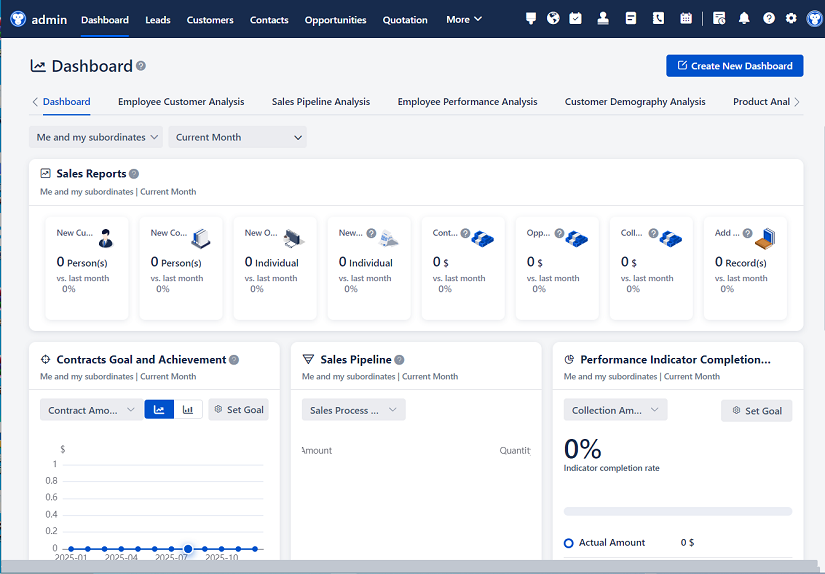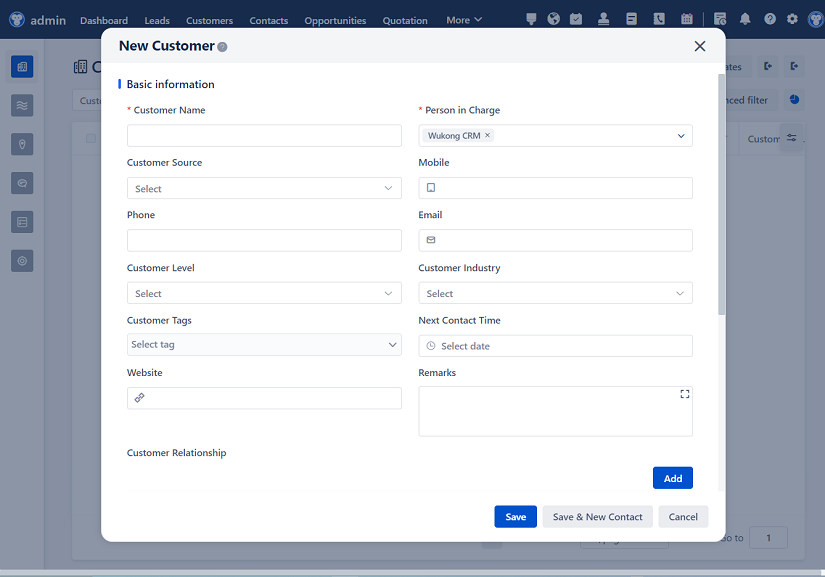
△Click on the top right corner to try Wukong CRM for free
Hey there! So, you're curious about CRM backend management systems, huh? Well, you've come to the right place. Let me break it down for you in a way that's easy to understand and, hopefully, not too boring.
First things first, what exactly is a CRM backend management system? Think of it as the brain behind the scenes of your customer relationship management (CRM) software. You know, the part that does all the heavy lifting while you focus on building relationships with your customers. It’s like having a super-smart assistant who keeps track of everything, from customer data to sales reports, and makes sure everything runs smoothly.
Now, why do we even need this kind of system? Well, imagine trying to manage all your customer information, sales data, and marketing campaigns without any help. It would be a nightmare, right? That’s where the CRM backend comes in. It helps you organize, store, and analyze all that data, so you can make better decisions and provide a top-notch experience for your customers.

Let’s dive a bit deeper into what a CRM backend actually does. For starters, it handles all the data storage. This means it keeps track of every single interaction you have with your customers, from emails and phone calls to in-person meetings. It’s like having a digital filing cabinet, but way more efficient and accessible. Plus, it’s not just about storing data; it’s also about making sure that data is secure. After all, you don’t want anyone getting their hands on sensitive customer information, do you?
Another key function of the CRM backend is data processing. This is where the magic happens. The system takes all that raw data and turns it into something useful. For example, it can generate reports that show you which products are selling the best, or which marketing campaigns are driving the most leads. It’s like having a personal analyst who crunches the numbers and gives you insights that can help you grow your business.
But wait, there’s more! A good CRM backend also supports automation. This means it can handle repetitive tasks, like sending out follow-up emails or scheduling appointments, without you having to lift a finger. It’s like having a robot assistant who never gets tired and always gets the job done. This not only saves you time but also reduces the chances of human error, which is always a plus.
Now, let’s talk about integration. A CRM backend should be able to play nicely with other tools and systems you use. Whether it’s your email marketing platform, your accounting software, or your e-commerce site, a well-integrated CRM backend ensures that all these pieces work together seamlessly. It’s like having a conductor who keeps all the instruments in harmony, creating a beautiful symphony of business operations.

One of the coolest things about a CRM backend is its ability to provide real-time analytics. Imagine being able to see how your sales are doing, or how many new leads you’ve generated, all in real-time. It’s like having a dashboard that gives you a bird’s-eye view of your business, so you can make informed decisions on the fly. No more waiting for monthly reports or sifting through spreadsheets—everything you need is right there, at your fingertips.
Of course, no system is perfect, and there are some challenges to consider when it comes to CRM backends. One of the biggest is data privacy and security. With so much sensitive information being stored, it’s crucial to have robust security measures in place. This includes things like encryption, access controls, and regular audits. You wouldn’t leave your front door unlocked, would you? The same goes for your CRM backend.
Another challenge is scalability. As your business grows, so will your data. A good CRM backend needs to be able to scale up and handle larger volumes of data without slowing down or crashing. It’s like upgrading your car to a bigger, more powerful model as your family grows. You want to make sure it can handle the extra load without breaking a sweat.

So, how do you choose the right CRM backend for your business? Well, it depends on a few factors. First, think about your specific needs. What features are must-haves for you? Do you need advanced analytics, or is basic reporting enough? Next, consider your budget. Some CRM backends can be pretty pricey, so make sure you’re getting the best bang for your buck. Finally, look at the support and training offered. A great CRM backend is only as good as the people who use it, so make sure you have the resources to get the most out of it.
Once you’ve chosen your CRM backend, the next step is implementation. This can be a bit of a process, but it’s worth it in the end. Start by planning out your data migration. If you’re moving from an old system, you’ll need to make sure all your existing data is transferred over correctly. It’s like packing up and moving to a new house—you want to make sure nothing gets lost or broken along the way.
Next, set up your user roles and permissions. This is important for maintaining security and ensuring that everyone has access to the data they need, but not more. It’s like giving each person in your household a key to the front door, but not to the safe in the basement. Make sure you have a clear plan for who can see and do what within the system.
Training is another critical step. Even the best CRM backend won’t do you much good if no one knows how to use it. Invest in training sessions for your team, and maybe even bring in a consultant to help with the transition. It’s like learning to drive a new car—once you get the hang of it, it’s smooth sailing.
Finally, don’t forget about ongoing maintenance and updates. A CRM backend is a living, breathing system that needs to be cared for. Regularly check for updates, perform backups, and keep an eye on performance. It’s like taking your car in for regular tune-ups to keep it running smoothly.
In the end, a CRM backend management system is a powerful tool that can transform the way you do business. It helps you stay organized, make data-driven decisions, and provide a better experience for your customers. Just remember, it’s not a one-size-fits-all solution. Take the time to find the right fit for your business, and you’ll be well on your way to success.
Alright, I hope that gave you a good overview of CRM backend management systems. Now, let’s wrap things up with a few questions and answers to help solidify what we’ve covered.
Q: What is the main purpose of a CRM backend management system? A: The main purpose of a CRM backend management system is to handle the storage, processing, and analysis of customer data, as well as to support automation and integration with other tools. It’s like the brain behind the scenes, making sure everything runs smoothly and providing valuable insights to help you make better business decisions.
Q: How does a CRM backend help with data security? A: A CRM backend helps with data security by implementing robust measures such as encryption, access controls, and regular audits. It’s like having a high-tech vault that keeps your sensitive customer information safe and sound.
Q: Can a CRM backend be integrated with other tools and systems? A: Absolutely! A good CRM backend should be able to integrate with other tools and systems, such as email marketing platforms, accounting software, and e-commerce sites. This ensures that all your business processes work together seamlessly, like a well-conducted orchestra.
Q: What are some challenges to consider when implementing a CRM backend? A: Some challenges include ensuring data privacy and security, scaling the system as your business grows, and choosing the right features and budget. It’s like preparing for a long journey—make sure you have the right vehicle, the right supplies, and a clear map to guide you.

Q: How do you choose the right CRM backend for your business? A: To choose the right CRM backend, consider your specific needs, your budget, and the support and training offered. It’s like picking the perfect pair of shoes—make sure they fit well, are comfortable, and will last you a long time.
I hope this helps! If you have any more questions, feel free to ask. Happy CRM-ing!

Related links:
Free trial of CRM
Understand CRM system
AI CRM Systems

△Click on the top right corner to try Wukong CRM for free